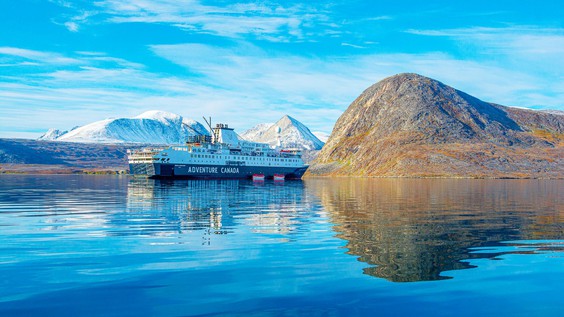 Canada-by-Sea encourages guests to enjoy the ultimate authentically Canadian voyage, with trips to the Arctic and to other intrinsically “Canadian” places. PHOTO BY DENNIS MINTY
Canada-by-Sea encourages guests to enjoy the ultimate authentically Canadian voyage, with trips to the Arctic and to other intrinsically “Canadian” places. PHOTO BY DENNIS MINTY
Canada-by-Sea. It sounds like something gangster Al Capone created to deflect attention from his bootlegging operations. Or perhaps a retirement community in South Florida. It’s neither. It’s the latest suite of cruises offered by an ‘off-the-map’ tour specialist based in suburban Toronto that taps this country’s largely unexplored marine landscape. As the world’s second-largest land mass, with more than 240,000 km of coastline, there’s plenty from which to choose.
Adventure Canada has rolled out five options for cruise aficionados who want more than shuffleboard and Sangria and are not afraid to clamber in and out of a Zodiac.
On their Atlantic and Arctic expeditions you’ll learn more about Indigenous history in Canada.
In the Far North, holidaymakers have two options: the Heart of the Arctic, and the High Arctic Explorer.
As well as sailing amid skyscraper-sized icebergs off the coast of Greenland, guests will meet Inuit artists in the community of Kinngait, formerly Cape Dorset, and will experience the harsh Baffin Island landscapes that have inspired generations of carvers and printmakers.
Explorer Martin Frobisher gave up a life of privateering nearly 450 years ago for a commission to discover a trading route to Asia — the fabled Northwest Passage. The “pirate of the Arctic” left behind a legacy of daring achievements, concedes historian Aaron Spitzer, “but also of killings and kidnappings, vanished crewmen, the first polar gold mine, entanglement in a notorious stock scam, and a failed attempt to establish the first English settlement in the New World.”
What Frobisher thought was the gateway to the Orient is now Iqaluit, formerly Frobisher Bay on southern Baffin Island, and modern adventurers can discover more in the Nunavut capital about the English mariner’s mixed relations with the locals — trusting on the one hand, duplicitous on the other.
On Frobisher’s third and final expedition to the Arctic, it was not his failed mining exploits or his uneven dealings with the Inuit that drove him back to England. It was simply that his supply of beer had gone bad. His sailing days weren’t over, though. He helped Sir Francis Drake fend off the Spanish Armada in 1588, for which he was knighted, and died in 1594.
North of the Arctic Circle, passengers can pay their respects to the lost Franklin Expedition at Beechey Island, a National Historic Site where three crew members from the ill-fated 1845 journey are buried amid desolate bluffs and shale beds. Small gravestones mark their final resting place.
Down south, or down east, depending on your perspective, Adventure Canada has a trio of cruises that — while not as top-of-the-world wild as the Arctic — nevertheless plunge passengers into a Canada few visit, from the wild horses of Sable Island to the breaching belugas of the Saguenay Fjord. A frisson of France is thrown in for good measure.
Take your pick from the Mighty Saint Lawrence, Newfoundland Circumnavigation or Atlantic Canada Explorer.
Here, too, you can delve deeper into the music, art, cuisine and heritage of First Nations peoples, in particular the Mi’kmaq, who are among the original inhabitants of the Atlantic provinces.
At the northern tip of Newfoundland, meanwhile, passengers circumnavigating Canada’s youngest province will poke into 1,000 years of Norse history at L’Anse aux Meadows, a UNESCO World Heritage Site and the only genuine Viking settlement site in North America. Period-style sod buildings and costumed guides bring their tale to life.
It’s ponies not people that will remain with visitors to Sable Island, located 300 km southeast of Halifax. A windswept sandbar home to only a handful of residents, the island is legendary for its colony of wild horses, which gallop unmolested along its 35-km length of dunes and saltmarshes, brought to the island in the 18th century as part of an unsuccessful farming settlement. Learn also about Sable’s grey seal colony, the world’s largest, and the buccaneering backstory behind its five centuries of shipwrecks.
Postmedia News - July 24, 2021

